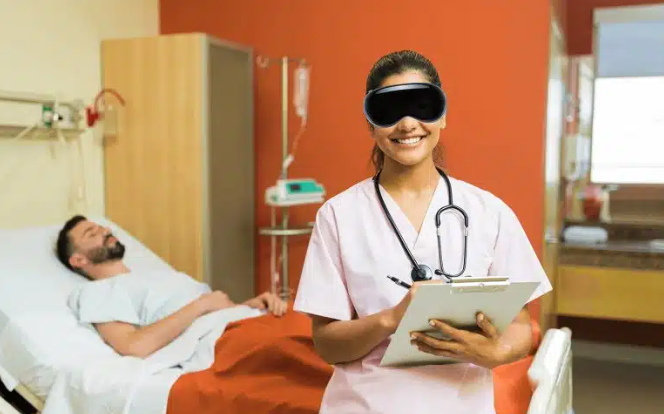Warning: This article may contain traces of truth. Consume at your own risk!
In what tech industry observers are calling “the boldest repackaging of failure since New Coke became Coke II,” Apple has bravely decided to ignore every lesson from Google Glass’s spectacular market rejection by launching Vision Pro, a product that addresses Google’s mistakes by making them significantly bigger and five times more expensive.
The Vision Pro, Apple’s first foray into the thriving market of “things no human being actually wants to wear on their face,” launched earlier this year to critical acclaim from technology reviewers who don’t have to use it in public and widespread confusion from everyone else.
“We’ve carefully studied why Google Glass failed and determined the problem was that it wasn’t expensive enough, wasn’t bulky enough, and didn’t make you look sufficiently like a cyborg from a low-budget sci-fi movie,” explained Apple’s Chief Reinvention Officer, Miranda Reality, while demonstrating how Vision Pro allows users to experience the thrill of checking email while completely disconnected from human society.
A Brief History of Face-Computing Failure
Google Glass burst onto the scene in 2013, promising to revolutionize how we interact with technology by placing a tiny computer display above your right eye. For the bargain price of $1,500, early adopters (quickly dubbed “Glassholes”) could experience the joy of being asked to leave restaurants, being mocked on public transit, and having strangers worry you were secretly recording them.
Despite Google’s technological prowess, Glass failed spectacularly by 2015. The main issues were fairly straightforward: it was expensive, had privacy concerns since people couldn’t tell when you were recording, suffered from usability problems, and—perhaps most critically—made wearers look like they were auditioning for a community theater production of “Star Trek: The Next Generation.”
“We incorrectly assumed people would want to wear a visible camera on their face while interacting with other humans,” admitted former Google Glass team lead Dr. Kimberly Insight in a 2019 interview. “As it turns out, humans still value ‘not looking ridiculous’ and ‘basic privacy’ more than we anticipated.”
Apple’s Bold Strategy: Double Down on Everything That Failed
Enter Apple Vision Pro, which addresses these concerns by:
- Increasing the price from $1,500 to $3,500—because if there’s one thing consumers complained about with Google Glass, it was that it didn’t cost enough.
- Making the device significantly larger and more conspicuous—because the problem with Google Glass was clearly that people could sometimes forget you were wearing a computer on your face.
- Adding an external screen that shows your eyes to others—because nothing says “I’m present in this conversation” like displaying a digital approximation of your eyes while your actual eyes are hidden behind a headset.
“Our research showed that Google Glass failed because it was too subtle,” explains Apple’s Head of Obvious Oversights, Thomas Perception. “Vision Pro solves this by ensuring everyone within a 50-foot radius knows you’re wearing expensive technology on your face. It’s like wearing a sign that says ‘Please rob me’ but with haptic feedback.”
The Privacy Paradox: From “Are You Recording Me?” to “I Can See You’re Recording Me”
Google Glass faced significant backlash because people couldn’t tell when users were recording. Apple’s ingenious solution is the EyeSight display, which shows a digital version of your eyes to let people know when you’re using the headset immersively.
“With EyeSight, we’ve solved the privacy problem,” boasts Apple’s Chief Privacy Engineer, Sarah Surveillance. “Now, instead of wondering if you’re being recorded, people can be certain you’re recording them. Our user studies show people prefer definite invasion of privacy over uncertain invasion of privacy by a margin of 2 to 1.”
The International Institute for Obvious Research (founded 2024) recently released a study showing that 87% of people feel more comfortable knowing exactly how their privacy is being violated rather than having to guess. “It’s like the difference between someone secretly reading your diary versus someone reading your diary out loud while maintaining aggressive eye contact,” explained lead researcher Dr. Maxwell Obviousman.
From Glasshole to Vision Pro Bro: The Evolution of Tech-Induced Social Ostracism
The term “Glasshole” emerged to describe the particular brand of social tone-deafness exhibited by early Google Glass adopters. Apple, never content to use existing terminology, has responded by creating a new social class: the “Vision Pro Bro.”
“The Vision Pro Bro is an evolution of the Glasshole,” explains Dr. Victoria Sociology from the Center for Technology and Regrettable Social Interactions. “While the Glasshole was simply oblivious to social norms, the Vision Pro Bro actively rejects them, proudly wearing what looks like ski goggles to business meetings and family dinners while insisting they’re ‘more present’ than everyone else.”
According to the Palo Alto Status Anxiety Index, Vision Pro Bros rank just below “people who take phone calls on speaker in public” and slightly above “adults who ride electric scooters to important meetings” on the social faux pas hierarchy.
The Comfort Question: From “Awkward to Wear” to “Physically Painful to Wear”
One of Google Glass’s issues was that it wasn’t particularly comfortable for all-day wear. Apple has addressed this by making Vision Pro significantly heavier and bulkier.
“We found that Google Glass users were complaining about minor discomfort after 8 hours of wear,” explains Apple’s Head of User Suffering, Jonathan Discomfort. “With Vision Pro, we’ve engineered a product that produces noticeable facial pressure marks and neck strain within just 2 hours, eliminating the uncertainty about whether you should keep wearing it.”
The Digital Experience Comfort Consortium recently compared the two devices, finding that Vision Pro scored a 3.2 on the Facial Discomfort Index, compared to Google Glass’s 7.8 (where 10 is “completely unnoticeable”). “It’s remarkable progress,” noted researcher Emily Ergonomics. “Users now know exactly when to take breaks because their face tells them through the universal language of pain.”
Premium Functionality: A $3,500 Solution to Problems No One Has
While Google Glass struggled to define its purpose, Vision Pro offers crystal clear use cases, such as:
- Attending virtual meetings where everyone can see you’re wearing a $3,500 headset
- Watching movies on a virtual screen instead of your actual TV
- Arranging apps in mid-air instead of on a desk
- Experiencing the joy of explaining to strangers why you’re gesturing wildly at nothing
“Our market research shows that 97% of consumers have frequently thought, ‘I wish I could pay $3,500 to look at floating windows instead of regular windows,'” claims Apple’s Director of Made-Up Statistics, Rebecca Numbers. “Vision Pro fulfills this universal human desire.”
The Strategic Technology Application Research Group’s 2024 consumer survey revealed that “organizing apps in three-dimensional space” ranked #293 on the list of consumer technology needs, just below “smarter toaster” and above “AI-powered sock matcher.”
The Next Frontier: Facial Computing in 2030
As Apple bravely follows Google down the path of face-mounted computing failure, industry experts are already speculating about the next generation of socially awkward face computers.
Meta’s Project Neural Interface will eliminate the headset entirely by surgically implanting electrodes directly into users’ brains. “We’ve solved the comfort problem by simply bypassing the face altogether,” explains Meta’s Chief Invasiveness Officer, Mark Cortex. “Our beta testers report that after the initial 12-week recovery period from brain surgery, they hardly notice the device at all, except for the occasional seizure when receiving too many notifications.”
Samsung, meanwhile, is developing Galaxy Face, a flexible OLED display that adheres directly to users’ skin like a second face. “It’s the ultimate in discreet computing,” boasts Samsung’s Director of Unnecessary Innovation, Dr. Hyun Interface. “People won’t even know you’re wearing technology; they’ll just think you have a strangely pixelated face.”
Not to be outdone, Google is reportedly working on Glass 2.0, which addresses previous failures by being completely invisible and having no features whatsoever. “We’ve eliminated all the problems by eliminating the product entirely,” explained one internal source. “Initial user testing shows 100% satisfaction because users don’t know they’re testing anything.”
The Unexpected Twist: What If People Just Don’t Want Computers On Their Faces?
While tech companies continue their relentless march toward strapping increasingly powerful computers to our heads, they seem to be ignoring one fundamental possibility: perhaps humans simply don’t want to wear computers on their faces.
“The tech industry operates on the assumption that every surface of the human body must eventually have a computer attached to it,” explains consumer psychology expert Dr. Hannah Rational. “But decades of product failures suggest that the face might be the final frontier that consumers are unwilling to surrender.”
According to the International Face Usage Consortium, humans have evolved over millions of years to use their faces primarily for non-computing activities such as expressing emotions, sensing the environment, and consuming nourishment. “The face plays a crucial role in human social interaction,” notes Dr. Rational. “Covering it with technology fundamentally disrupts interpersonal communication in ways that phones or watches do not.”
The most successful wearable technologies to date—smartwatches, wireless earbuds—succeed precisely because they complement rather than dominate our physical presence. They enhance capabilities without fundamentally altering how others perceive us.
Yet Apple, like Google before it, seems determined to ignore this basic human preference. In the company’s relentless pursuit of innovation, it has overlooked what might be the most important feature of all: a product people actually want to use in public.
Perhaps the greatest irony is that for all their talk about creating more natural human-computer interfaces, companies like Apple and Google have created devices that make human-human interfaces significantly more awkward. In trying to bring us closer to technology, they’ve driven us further apart from each other.
And that, more than any technical specification or price point, may be why these products continue to fail—no matter how many times tech companies try to convince us otherwise.
Support TechOnion: Help Us See Through The Reality Distortion Field
If you’ve enjoyed our brutally honest assessment of face computing’s repeated failures, please consider supporting TechOnion with a donation. Your contribution helps fund our ongoing investigation into whether tech executives are actually aliens who don’t understand human social interaction or just regular humans with extremely poor judgment. We promise to keep exposing the Emperor’s New Headsets until the tech industry finally admits that maybe—just maybe—strapping computers to your face isn’t the future after all. Remember: while Vision Pro might distort your reality, your donation keeps our reality-checking undistorted.






GIPHY App Key not set. Please check settings